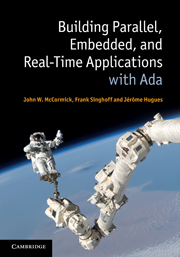Book contents
- Frontmatter
- Contents
- List of illustrations
- List of tables
- Foreword
- Preface
- 1 Introduction and overview
- 2 Sequential programming with Ada
- 3 Task basics
- 4 Communication and synchronization based on shared objects
- 5 Communication and synchronization based on direct interaction
- 6 Distributed systems with Ada
- 7 Real-time systems and scheduling concepts
- 8 Real-time programming with Ada
- 9 Tools for building and verifying real-time applications
- References
- Index
2 - Sequential programming with Ada
Published online by Cambridge University Press: 01 June 2011
- Frontmatter
- Contents
- List of illustrations
- List of tables
- Foreword
- Preface
- 1 Introduction and overview
- 2 Sequential programming with Ada
- 3 Task basics
- 4 Communication and synchronization based on shared objects
- 5 Communication and synchronization based on direct interaction
- 6 Distributed systems with Ada
- 7 Real-time systems and scheduling concepts
- 8 Real-time programming with Ada
- 9 Tools for building and verifying real-time applications
- References
- Index
Summary
In this chapter we will introduce you to the basic sequential features of the Ada programming language. You may find it useful to skim this chapter on first reading and then return to it when you encounter an unfamiliar language feature in later chapters. One chapter is not adequate to discuss all aspects of sequential programming with Ada. We discuss those that are most relevant to concurrent, embedded, and real-time programming and the examples used in this book. Barnes (2006) presents a comprehensive description of the Ada programming language. Ben-Ari (2009) does an excellent job describing the aspects of Ada relevant to software engineering. Dale et al. (2000) provide an introduction to Ada for novice programmers. You can find Ada implementations of the common data structures in Dale and McCormick (2007). There are also many Ada language resources available online that you may find useful while reading this chapter including English (2001), Riehle (2003), and Wikibooks (2010a). We will often refer you to the ARM, the Ada Reference Manual (Taft et al., 2006), which is available in both print and electronic forms.
DeRemer and Kron (1975) distinguished the activities of writing large programs from those of writing small programs. They considered large programs to be systems built from many small programs (modules), usually written by different people. It is common today to separate the features of a programming language along the same lines.
- Type
- Chapter
- Information
- Publisher: Cambridge University PressPrint publication year: 2011



